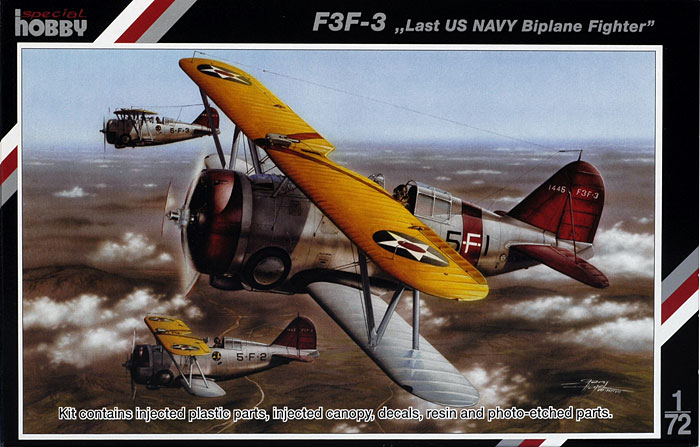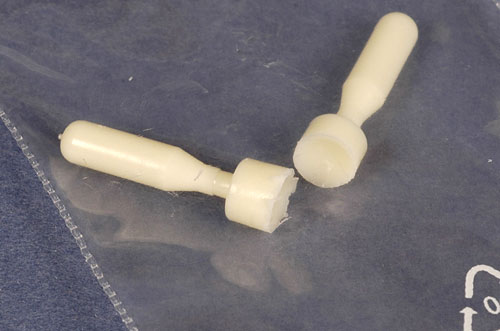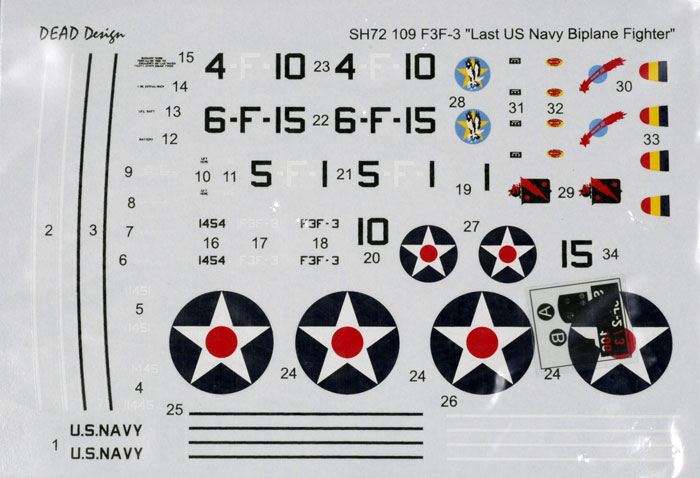|
Grumman F3F-3
“Last U.S. Navy
Biplane Fighter”

Special Hobby, 1/72 scale
S u m m a r y
|
|
Catalogue Number: |
Special Hobby SH 72109
F3F-3 Biplane Fighter |
|
Scale: |
1/72 |
| Contents and
Media: |
51
dark grey plastic parts on one sprue, 1 clear injected
plastic canopy on one sprue, 7 cream coloured resin parts on
three casting blocks, 24 PE parts on one fret, decals for
three aircraft plus an A5 sized, 10 page instruction booklet
with history, parts plan, 4 pages of build drawings and 3
pages of paint/decal instructions. |
| Price: |
From GBP£8.21 available online
from Hannants
and specialist
model retailers worldwide |
| Review Type: |
FirstLook |
| Advantages: |
Good detail for a
Braille Scale kit, injected plastic canopy, excellent
decals. |
| Disadvantages: |
Instructions are a bit
vague in places, no full rigging diagram, multi-media, not
for beginners |
|
Recommendation: |
Highly Recommended to
experienced modellers. |
Reviewed by Glen Porter

Special Hobby's 1/72 scale F3F-3 will be available online from Squadron.com
A Brief History
The
Grumman F3F was designed in the mid-thirties as a replacement for the
F2F. The F3F-1 entered service in January 1936 followed by the more
powerful F3F-2 with VF-6 Squadron on USS Enterprise, late 1936 early
1937. December 1938 saw the introduction of the F3F-3 with VF-5
(Yorktown) and VF-7 (Wasp). This was the last of the series and the last
Biplane Fighter flown by the Navy. The last operational unit was Marine
Squadron VMF-211 who retired their F3F-3s on the 10th of October 1941.
The
Model
This
is the third F3F issued by MPM/Special Hobby. The first was the F3F-1
under the MPM label about four or five years ago and then came the F3F-2
by Special Hobby (Kit No SH 72106) in 2005. This F3F-3, also by Special
Hobby, is almost identical to the -2 and I would suggest
reading that review first before this one.
The differences between the two kits, apart from the instructions,
decals and box art, is this kit has both cowlings (-2 had only one) and
two resin bombs ( the -2 did have the bomb mounts).

Click the thumbnails below to view larger images:
[../../../photogallery/photo00031931/real.htm]
The
kit contains only one plastic sprue in mid grey with, as we've come to
expect from this manufacturer, next to no flash, some ejector pin marks
but only on interior surfaces and very fine engraved panel detail,
raised where appropriate. Most parts will require a small amount of
clean-up.
The small injected one-piece canopy is very clear and thin and may be
able to be displayed open.
Four of the seven resin parts are for the cockpit interior, floor, two
side consoles and a small box glued onto the right hand console. The
other three are the two bombs and a small matrix for the under-nose air
intake. The two bombs need a casting block removed from their rear and
PE fins bent up and installed. Unfortunately, this is not mentioned or
shown in the instructions so look at the parts carefully.

The PE fret by Eduard has instrument panel, rudder pedals, lap harness,
bomb racks, bomb tail fins and various other small parts, some for the
interior and exterior.
Decals by Dead Design are well printed with good register, colour
density and minimum carrier film and cover three aircraft in the very
colourful pre-war scheme.
-
“A” is F3F-3, BuNo 1445, USS Yorktown USA East Coast, Nov, 1939,
with Red trim.
-
“B” is F3F-3, BuNo 1451, USS Enterprise, August 1940, with Blue
tailplane, fin and rudder, Light Green lower cowling and upper wing
chevron but no fuselage band.
-
“C” is F3F-3, BuNo 1454, USS Ranger in the Atlantic Ocean, 1940,
with Light Green Tail surfaces and Black cowling, upper wing chevron
and fuselage band.

All
necessary markings are present on the sheet.
Known
as “The Flying Barrel”, the F3F is one of those aircraft that is so ugly
it becomes attractive and is now well catered for in both major aircraft
model scales.
Because it has “N” shaped inter-plane struts it should be a little
easier to mount the top wing than most biplanes with individual or “V”
struts. However, these struts lean out-wards so care will still need to
be taken.
Apart from that, and the inclusion of resin and PE, there is nothing
here to tax the modeller too much and it is an aircraft that every good
collection should have.
Highly Recommended to experienced modellers.
Thanks to MPM/Special Hobby for the review sample.
Review Text Copyright © 2007 by Glen Porter
Images Copyright © 2007 by Brett Green
Page Created 25 September, 2007
Last updated 24 December, 2007
Back to HyperScale Main Page
Back to Reviews Page
|
Home
| What's New |
Features |
Gallery |
Reviews |
Reference |
Forum |